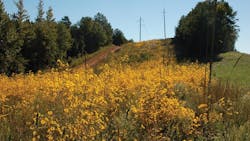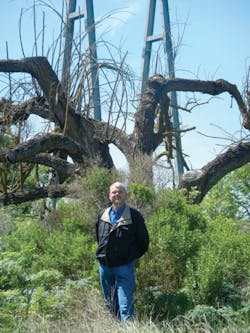We have seen a marked increase in weather-based events that adversely impact the ability of utilities to deliver power to their customers. This increase has been so dramatic over the past decade that many utility executives and regulatory bodies now no longer treat storms as isolated events but as business as usual or, more accurately, as “the new normal.” And this new normal requires a heightened level of investment.
Storm Hardening
Consider that Public Service Electric and Gas Co. recently reached a US$1.22 billion settlement in its Energy Strong proposal to proactively protect and strengthen its electric and gas systems against severe weather conditions. The stipulation, signed by the staff of the New Jersey Board of Public Utilities, is now being reviewed by the other parties and participants in the case, and will be submitted to the New Jersey BPU for review and approval. This is happening all across the country.
Of course, we know that in many utility service areas, the majority of damage to overhead lines is a result of falling trees, limbs and contact from line sway taking out these power lines during storms. And we know one of the best ways to harden a circuit is to reduce the threat of those falling trees and limbs.
Connecticut Light and Power, a Northeast Utilities company, realized the need to further understand the storm-hardening dynamics between vegetation management and the power-delivery system. Presently, CL&P is working with the University of Connecticut to improve not only weather prediction but also weather-based damage prediction. By adding vegetation vulnerability to damage modeling, the utility can better allocate resources for emergency response. In addition, CL&P can use these predictive tools to locate predicted storm trouble spots and take necessary action.
Having community-based solutions in place will help reduce tree-based risks along power lines, as well. Many utilities now provide financial support for homeowners to plant appropriate low-canopy trees in the vicinity of power lines. This also gives utilities an opportunity to reach out to their communities with a positive message and stay in good favor.
By taking a holistic view to mitigate storm risk by investing in both vegetation management and grid hardening, as well as by investing resources in a more targeted manner, utilities will be better prepared when the next major storm hits.
Trees and Transmission
Making the system more resilient to vegetation-caused damage is only half the story. We must also speed response times to get power back up faster. More than ever, utilities and their vendor partners are able to facilitate the dispatch of tree trimming and clearing crews. Access to GPS-enabled trucks and to better outage management dispatch tools allows utilities to know their crew locations at all times.
Transmission facilities provide a slightly different challenge. For a utility to harden its grid, it needs to look at hazard trees within and outside the documented easement. Here, as near distribution lines, danger trees that are defective or dying can be removed prior to a storm. But green trees can cause an outage during a storm event, as well. Utilities are responsible for providing reliable power; therefore, they need to have a documented program to reduce and eliminate outages caused by hazard trees, and to reduce the potential for healthy trees to be blown into transmission lines.
Expect regulators to hold utilities responsible for transmission outages that could have been prevented if they had a comprehensive approach in place, including hazard tree patrols. Utilities should consider developing a protocol that includes the requirements of the International Society of Arboriculture Tree Risk Assessment Qualifications for their employees and contractors. Demonstrating a professional program will be helpful when regulators ask questions about storm reliability.
Sustainable Vegetation
The goal of a transmission vegetation management plan is to allow zero outages from grow-ins within the right-of-way (ROW) while reducing or eliminating any fall-ins from outside the ROW.
Forward-thinking utilities manage vegetation within their ROWs toward low-growing vegetation types over several cycles, while the trees outside the ROW need a comprehensive plan to improve reliability over time. Then, when severe weather strikes, the potential damage to delivery circuits will be reduced significantly.
Thorough industry standards and guides are now available to assist utilities in developing these plans. For example, ANSI A300 Integrated Vegetation Management (IVM) Part 7 outlines best management practices for managing compatible vegetation within electric utility ROWs. This plan can help vegetation managers determine the options to reach sustainable vegetation types, and meet landowner and agency requirements. After all, methods used to reduce storm-based risks associated with vegetation on ROWs also must be acceptable to appropriate landowners and government entities.
ROW mowing and follow-up with high-volume broadcast herbicide applications may meet a utility’s immediate needs while also meeting the needs of the individual or organizations responsible for the land in question. For example, using herbicides on wildlife reserves on federal lands may be quite appropriate and acceptable. Similarly, the use of selective herbicides to establish grasses and eliminate noxious weeds on a ranch property may help create a sustainable vegetation type that benefits the landowner; meanwhile, other private landowners may prefer mechanically mowed ROWs.
Creating low-growing and environmentally sustainable vegetation will help harden a ROW by eliminating any encroachments into the wire zone and reduce annual budgets over time, leaving funding that can be focused on susceptible circuits. It is incumbent on the vegetation manager to know the succession ecology of each site and determine the compatible species that will recolonize the site. Developing compatible species can be different at each site, depending on the desires and needs of adjacent landowners.
Today’s herbicide programs include herbicides that are more environmentally friendly because they only require ounces per acre and are applied using very selective application methods. Other IVM techniques, like manual or mechanical, have restrictions, such as limited operating periods in order to protect threatened, endangered and sensitive species or cultural resources.
Transmission ROWs that maintain sustainable vegetation types need to use adaptive management to monitor the success of past treatments and to make adaptations over cycles. A utility can do this over large sections of the ROW or pick demonstration sites to develop future management strategies.
Once a ROW has reached sustainable vegetation cover, annual maintenance costs will decrease over a few cycles and then stabilize. The first cycles of enhancement will usually be foliar with higher sprout densities from mechanical options. The next cycles will be low-volume foliar applications, which are usually less than 15% of the cost of mechanical options. The following cycles will be spot foliar applications, or basal stem, and can be less than 25% of the foliar application. At this point, maintenance can be done over longer cycles with significant reductions in maintenance costs.
Developing a programmatic and well-planned cycle budget is also important to maintaining support from senior management. Be sure to demonstrate the differences in costs per acre for manual, mechanical, chemical and biological options. Senior management will recognize the value of a comprehensive plan that includes all IVM options.
Strong Partnerships
Successful vegetation managers are skilled at communicating with internal and external partners and stakeholders. Taking a leadership role in recognizing the diverse goals within a utility to educate, build trust and gain support for its IVM programs are essential elements of a successful program.
Internal stakeholders are generally departments — media, government relations, customer care, environmental specialists and environmental stewardship — that can be affected by public and agency comments. Vegetation managers should build relationships with the leadership of each department. Taking time to understand their issues will help further develop a comprehensive strategy to gain their support.
Utility media representatives can benefit from utility vegetation leaders who can set up field meetings with TV and radio crews on storm preparation, reliability improvement programs and environmental partnerships. Arranging interviews with environmental leaders to discuss the benefits of IVM and specifically the selective use of herbicides can help build credibility for a utility’s program. These media relationships will create understanding and trust, which will be beneficial when an unusual event happens that threatens a utility’s image and IVM program.
Government departments are responsible for managing city, county and federal relationships, which are critical to many departments within the utility. Planning annual field days to see the benefits of a best-in-class IVM program can help develop understanding and trust in a utility’s professional program. Know which agencies have issues and look for opportunities to develop demonstration sites that address their concerns such as riparian buffers, migratory birds or noxious weed control. Demonstration sites should be strategic and include herbicides and application methods that will help support IVM options.
Customer care is responsible for improving and maintaining the customer satisfaction. Unplanned vegetation management projects that do not inform adjacent landowners can result in a fire storm of controversy. IVM procedures from manual mowing to herbicide applications can cause issues if landowners are not contacted prior to the start of operations. Field meetings with landowners can help facilitate a compromise to meet the goals of each party.
Environmental specialists are good partners for vegetation management programs. Coordinate field trips to ROWs to initiate discussions about their concerns and how the utility’s IVM program can help gain their support. Look for opportunities to adjust current IVM options to address biological issues.
The environmental stewardship department manages a utility’s sustainability image. Vegetation managers can provide opportunities to develop statements and images for the annual environmental sustainability report. Recognizing the miles and acres of sustainable vegetation on ROWs that are managed for many environmental values can help support the utility’s image. Including the best management practices of Closed Chain of Custody for herbicide use in contracts supports environmental concerns with recycling of containers. The utility’s website should include examples of ways its utility vegetation management (UVM) program supports environmental sustainability.
Obtaining ROW Stewardship Accreditation will help a utility’s IVM program gain credibility with both internal and external stakeholders. Dovetail Partners is the third-party certification manager of the program. Dovetail Partners also manages the Forest Stewardship Council certification program for timberland owners. Dovetail Partners’ vision is to be the most trusted source of environmental information and to support excellence and environmental stewardship in responsible vegetation management within high-voltage electric transmission corridors. The accreditation is an opportunity for a utility to gain initial recognition for its program, but it also requires annual progress updates to improve the program over five-year cycles.
Proper Planning
Hardening is not just an engineering solution. Vegetation managers develop a comprehensive and intelligent approach to their UVM program that will improve reliability, stabilize budgets, and develop internal and external partnerships.
Every UVM program needs to be hardened from internal and external influences. A comprehensive plan is necessary to protect a utility’s UVM program from influences that could affect the IVM techniques that can be used to maintain a safe and reliable ROW. By preparing now for possible future challenges to an IVM program, utility vegetation managers will be able to successfully negotiate through environmental and social challenges.
Preparation for and response to storms is an ongoing process. Collaboration will help significantly reduce damages incurred to transmission and distribution lines caused by falling trees and limbs while speeding the response for those lines that are taken out because of storms.
Proper planning is key for utilities to prepare their systems to withstand major storm events. The good news is that once a utility has gone through a complete cycle of its comprehensive UVM plan, developed with community and vendor partners, it is properly prepared for what Mother Nature throws its way.
Editor’s note: This article was independently written by Nelsen Money ([email protected]), as contracted by the editorial director of Transmission & Distribution World. Money, president of NRM-VMS Inc., has 40 years of utility vegetation management experience. He is an ISA Certified Arborist/Utility Specialist, a California Licensed Professional Forester and a California Licensed Pest Control Advisor. He is also a past president of the Utility Arborist Association.


